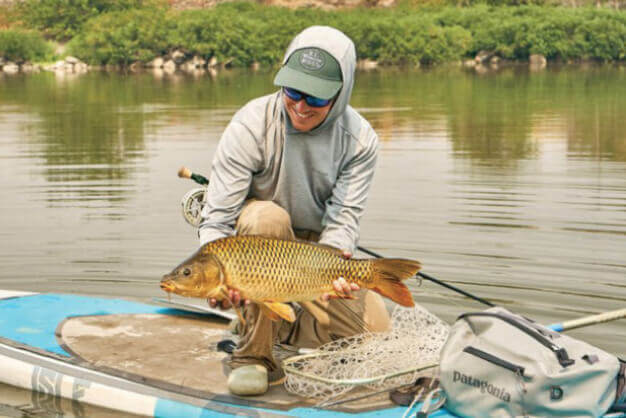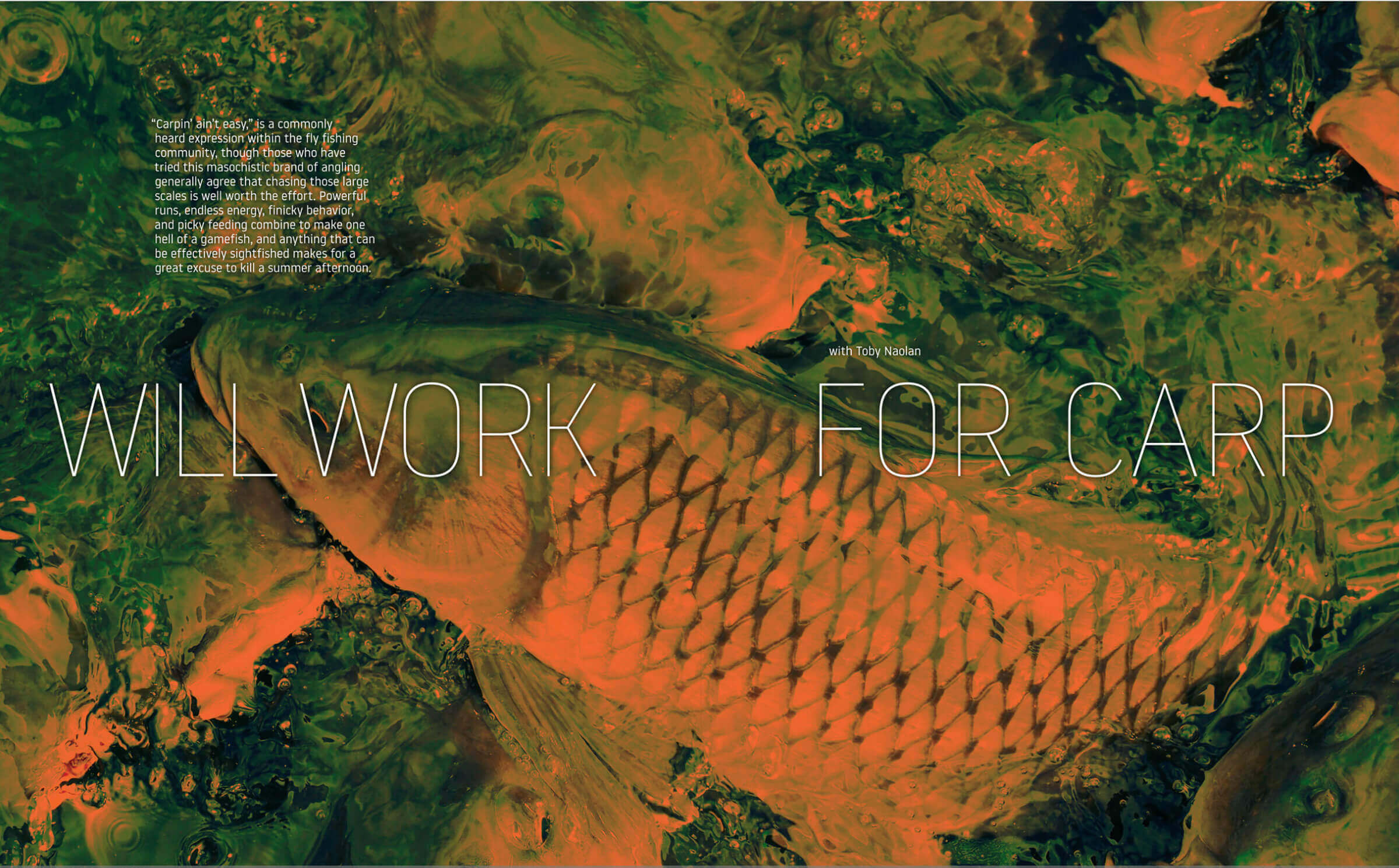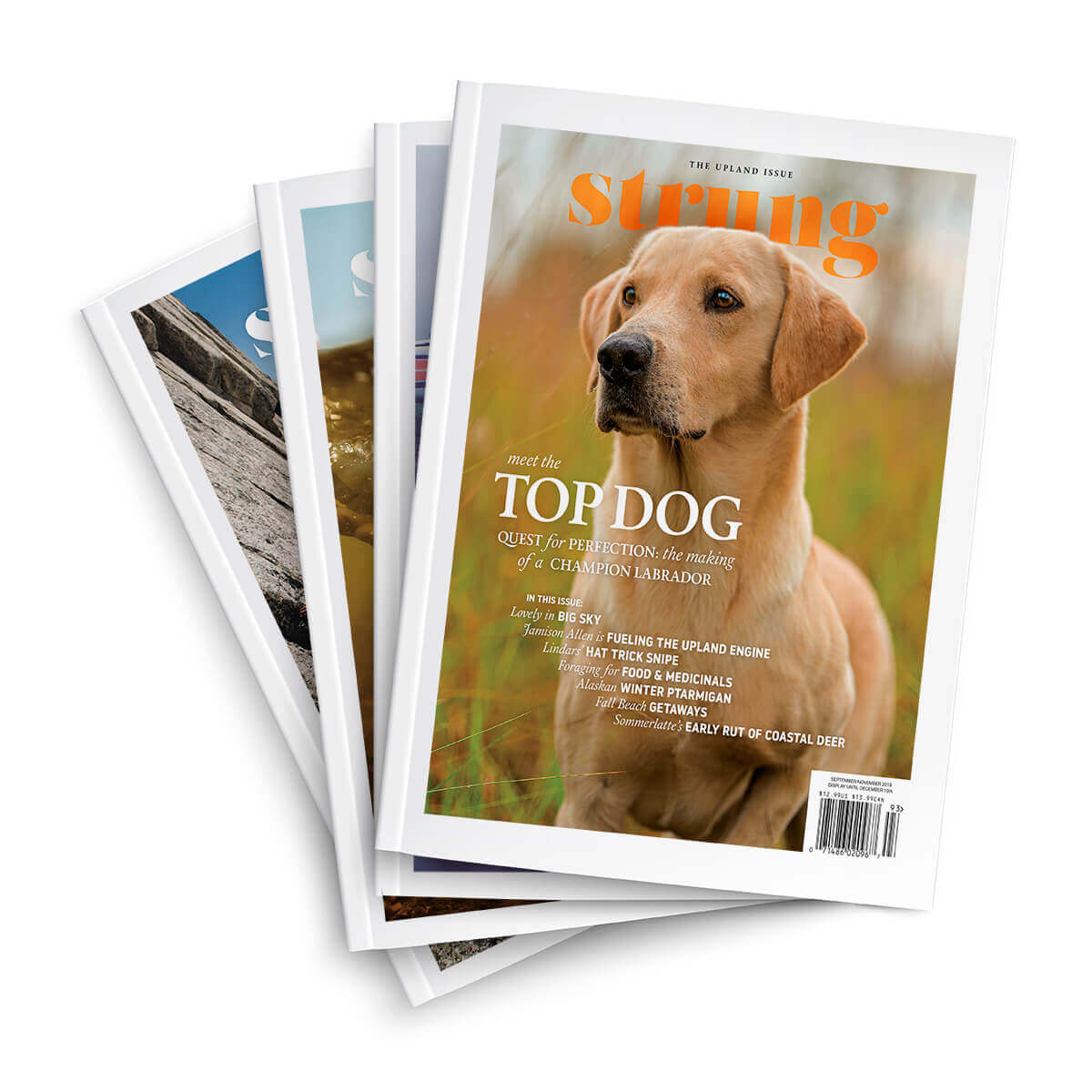During our post-fish beer and debrief we went through the usual steps of replaying the day’s highs and lows; we both agreed that the day would have ended in a goose egg if it weren’t for getting creative.
By Toby Nolan
“Carpin’ ain’t easy,” is a commonly heard expression within the fly fishing community, though those who have tried this masochistic brand of angling generally agree that chasing those large scales is well worth the effort. Powerful runs, endless energy, finicky behavior, and picky feeding combine to make one hell of a gamefish, and anything that can be effectively sight-fished makes for a great excuse to kill a summer afternoon.
Oregon’s Columbia River is famous for its large sandy flats, clear water and immense carp which regularly push beyond twenty pounds and occasionally surpass the magical thirty pound mark. Feeding primarily on stationary freshwater clams, they are unlikely to move more than a few inches to take a fly. This requires incredibly accurate casting, stealthy wading and the ability to handle rejection well.
Whether you fish for carp, trout, steelhead, tarpon, bonefish or any other species, no two days of fishing are the same. Daily conditions are at the mercy of weather, angling pressure, water temperature, seasonal food changes, and even your own mood. Some days don’t go according to plan. Some days require getting creative if fish are to be brought to hand.
In the summer of 2018, Oregon was ablaze with wildfires, as it had been the previous summer. More than 800 documented fires burned over 400,000 acres, destroying property, historic landmarks and forests as they swept across the state. As a result, much of the Northwest was cast into a perpetual state of dim light under grey skies thick with smoke. Not the best conditions for sight fishing to such particular fish.
 Undeterred by the obvious challenges, Pat Perry and I met early one morning for a Columbia carp trip. As we geared up, we theorized about the conditions and made our predictions for the day. I knew the area well, having fished it countless times as I worked my hardest to figure out the complex fishery. Though newer to the area, Pat had fished it the day before. As we stood in the parking area, he remarked on the alarming rise in water levels from releases upriver. Impeded by fourteen major dams, today’s Columbia is a far cry from the raging river that Lewis and Clark battled in 1805. These water releases often cause unsettling surges of cold water that immediately alter fish behavior not to mention the comfort of the lower half of your body. Between the discriminant carp, smoky skies, and cold, high water we knew we were facing an upstream battle.
Undeterred by the obvious challenges, Pat Perry and I met early one morning for a Columbia carp trip. As we geared up, we theorized about the conditions and made our predictions for the day. I knew the area well, having fished it countless times as I worked my hardest to figure out the complex fishery. Though newer to the area, Pat had fished it the day before. As we stood in the parking area, he remarked on the alarming rise in water levels from releases upriver. Impeded by fourteen major dams, today’s Columbia is a far cry from the raging river that Lewis and Clark battled in 1805. These water releases often cause unsettling surges of cold water that immediately alter fish behavior not to mention the comfort of the lower half of your body. Between the discriminant carp, smoky skies, and cold, high water we knew we were facing an upstream battle.
Beginning with our usual approach, we waded thigh-deep across sandy flats in the hopes of being able to spot tailing carp. An hour of fishing resulted in a couple of fast moving, spooked fish, but nothing more. We had a decision to make: continue wading and risk a skunking or get creative. We agreed that the fish were most likely further out than we could reach on foot, unless swimming became part of the plan. We would need a different way to access the deeper water, and preferably one that gave us a height advantage to try and combat the reduced visibility caused by wildfire smoke. Thankfully, Pat had come prepared with an inflatable paddle board.
We headed back to the water full of the blinding optimism that only a seasoned angler can appreciate. Pat took a reconnaissance paddle and quickly confirmed our suspicion that the carp were feeding amongst the submerged weed beds that grew just beyond the reach of our wading efforts. I stood and watched Pat excitedly point out and cast to a handful of fish that were moving and feeding around him. I watched intently, hoping to see a sudden hook-set and the paddleboard lurch from the pull of a twenty pound brute. After fifteen minutes, he paddled back to shore and regaled me with the fish he had seen and their cold-hearted refusals. We reminded ourselves that we were pursuing Columbia river carp and, like casting to bonefish and permit, finding them was but a fraction of the challenge.
 I knew of a large, shallow lagoon that I felt could be a good option for us to find fresh fish. What would normally be a long and sweaty hike through stream side bramble became a short and leisurely paddle to our new destination. Leisurely for me that is, since Pat, in a true act of chivalry, offered to paddle my two hundred pound mass all the way there. Upon arrival, I began skirting the shoreline for any fish that may have been sitting close to the edge. Pat continued to patrol the deeper areas from the paddle board. It didn’t take long before the unmistakable holler of a person who has just hooked a fish came rippling across the water. I looked back to see Pat connected to a Columbia River carp. It towed him around the lagoon like a clydesdale hitched to a Radio Flyer, testing his balance and agility the entire time. Together they made a full circuit of the area before heading back my way. Eventually he managed to get the fish close to the paddle board, squat down, and scoop it into his net – an accomplishment that would elude most. Hoots, hollers and high fives ensued, followed by some quick photos, before the fish was released back to its haunt.
I knew of a large, shallow lagoon that I felt could be a good option for us to find fresh fish. What would normally be a long and sweaty hike through stream side bramble became a short and leisurely paddle to our new destination. Leisurely for me that is, since Pat, in a true act of chivalry, offered to paddle my two hundred pound mass all the way there. Upon arrival, I began skirting the shoreline for any fish that may have been sitting close to the edge. Pat continued to patrol the deeper areas from the paddle board. It didn’t take long before the unmistakable holler of a person who has just hooked a fish came rippling across the water. I looked back to see Pat connected to a Columbia River carp. It towed him around the lagoon like a clydesdale hitched to a Radio Flyer, testing his balance and agility the entire time. Together they made a full circuit of the area before heading back my way. Eventually he managed to get the fish close to the paddle board, squat down, and scoop it into his net – an accomplishment that would elude most. Hoots, hollers and high fives ensued, followed by some quick photos, before the fish was released back to its haunt.
We fished out the rest of the day managing one more fish to hand before we called it and headed back to the parking lot. During our post-fish beer and debrief we went through the usual steps of replaying the day’s highs and lows; we both agreed that the day would have ended in a goose egg if it weren’t for getting creative.
Toby Nolan is a freelance photographer and writer specializing in fly-fishing, adventure tourism, travel and lifestyle. Originally from Dublin, Ireland, Toby now calls Bend, Oregon home where he lives with his wife Laura.
Originally published in Strung #3 – Summer 2019
[/vc_column_text][/vc_column][/vc_row]



